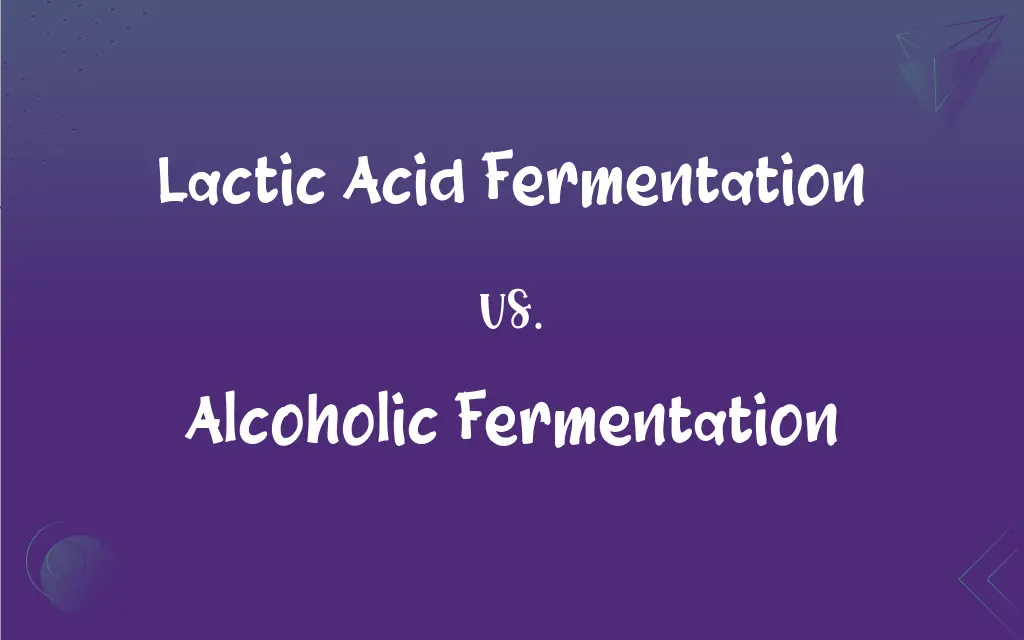Lactic Acid Fermentation vs. Alcoholic Fermentation: What's the Difference?
Edited by Aimie Carlson || By Harlon Moss || Updated on October 19, 2023
Lactic acid fermentation produces lactic acid from glucose, while alcoholic fermentation yields ethanol and carbon dioxide.

Key Differences
Lactic acid fermentation is a biological process that converts sugars, primarily glucose and galactose, into cellular energy and lactate. In contrast, alcoholic fermentation is the conversion of sugars into ethanol and carbon dioxide, mainly executed by yeasts.
Both lactic acid fermentation and alcoholic fermentation are anaerobic processes, meaning they occur in the absence of oxygen. However, while the former produces lactic acid as its main byproduct, the latter results in ethanol and carbon dioxide.
Lactic acid fermentation often takes place in muscle cells during intense exercise when oxygen becomes limited, leading to the characteristic burning sensation. On the other hand, alcoholic fermentation is responsible for the production of alcoholic beverages like beer and wine, where yeasts convert sugars from grains or fruits into alcohol.
In the food industry, lactic acid fermentation is used to produce dairy products like yogurt and cheese, and fermented vegetables like pickles and sauerkraut. Whereas alcoholic fermentation is harnessed for making beverages, it's also crucial for baking, as the carbon dioxide produced helps bread rise.
Organisms such as bacteria, particularly lactobacilli, are primarily responsible for lactic acid fermentation. In contrast, alcoholic fermentation is mainly carried out by yeasts, though some bacteria like Zymomonas mobilis can also perform this type of fermentation.
ADVERTISEMENT
Comparison Chart
Primary Byproduct
Produces lactic acid.
Produces ethanol and carbon dioxide.
Common Organisms
Mainly bacteria, especially lactobacilli.
Primarily yeasts.
Industrial Applications
Used in dairy products, pickles, sauerkraut.
Used in alcoholic beverages, baking.
Occurrence in Humans
Occurs in muscles during intense exercise.
Does not naturally occur in human cells.
Reaction Overview
Sugars → Lactic acid.
Sugars → Ethanol + Carbon dioxide.
ADVERTISEMENT
Lactic Acid Fermentation and Alcoholic Fermentation Definitions
Lactic Acid Fermentation
Lactic acid fermentation occurs in certain bacteria and fungi.
Certain dairy products owe their tangy taste to lactic acid fermentation.
Alcoholic Fermentation
Alcoholic fermentation is used in baking to make dough rise.
Bakers use yeast for alcoholic fermentation, making bread fluffy.
Lactic Acid Fermentation
Lactic acid fermentation results in a drop in pH in the surrounding environment.
The sour taste of yogurt is due to the lactic acid produced during lactic acid fermentation.
Alcoholic Fermentation
Alcoholic fermentation converts sugars into alcohol.
Distillers depend on alcoholic fermentation to produce spirits like whiskey.
Lactic Acid Fermentation
Lactic acid fermentation is pivotal in food fermentation processes.
Sauerkraut is produced through lactic acid fermentation of cabbage.
Alcoholic Fermentation
Alcoholic fermentation results in both alcohol and carbon dioxide.
The bubbles in beer are due to the carbon dioxide released during alcoholic fermentation.
Lactic Acid Fermentation
Lactic acid fermentation produces energy in the absence of oxygen.
When sprinting, muscles might undergo lactic acid fermentation.
Alcoholic Fermentation
Alcoholic fermentation contributes to the flavor profile of fermented drinks.
Different strains of yeast can influence the taste of the wine through alcoholic fermentation.
Lactic Acid Fermentation
Lactic acid fermentation is an anaerobic conversion of glucose to lactate.
During intense exercise, muscles resort to lactic acid fermentation for energy.
Alcoholic Fermentation
Alcoholic fermentation is the anaerobic process by which yeasts produce ethanol.
Wine production relies on alcoholic fermentation of grape sugars.
FAQs
How does alcoholic fermentation influence bread-making?
The carbon dioxide produced during alcoholic fermentation helps the dough rise, making bread light and airy.
What is the primary byproduct of lactic acid fermentation?
Lactic acid is the main byproduct of lactic acid fermentation.
What alcoholic beverage relies heavily on alcoholic fermentation?
Wine, among others, relies on alcoholic fermentation for its production.
Can alcoholic fermentation occur without yeast?
While yeasts are the primary agents, certain bacteria can also execute alcoholic fermentation.
Why do muscles burn during intense workouts?
This is often due to lactic acid accumulation from lactic acid fermentation when oxygen is scarce.
What gives yogurt its sour taste?
The sour taste is due to lactic acid produced during lactic acid fermentation.
Is the alcohol produced in alcoholic fermentation always ethanol?
Primarily yes, but conditions and organisms might yield other alcohols in trace amounts.
Are only bacteria responsible for lactic acid fermentation?
No, while bacteria like lactobacilli are common agents, some fungi also perform lactic acid fermentation.
Is alcoholic fermentation essential for beer production?
Yes, it's a crucial step where sugars are converted to alcohol and carbon dioxide.
Why is lactic acid fermentation important in food preservation?
The acid produced lowers the pH, making it less hospitable for spoilage microbes.
Why is it called "alcoholic" fermentation?
Because one of its primary products is alcohol (ethanol).
Can lactic acid fermentation occur in human cells?
Yes, especially in muscle cells during intense exercise when oxygen is limited.
Are the products of lactic acid fermentation always safe to consume?
While commonly safe, some strains might produce toxins or undesirable compounds.
Can all sugars undergo alcoholic fermentation?
Most fermentable sugars can, but the efficiency and end products might vary.
What role does lactic acid fermentation play in cheese production?
It acidifies the milk, leading to curdling, essential for cheese-making.
How does the accumulation of lactic acid affect muscle performance?
It can lead to muscle fatigue and a burning sensation.
Why is oxygen detrimental to lactic acid fermentation?
Oxygen presence shifts the cellular metabolism to aerobic pathways, hindering lactic acid production.
What gives beer its alcoholic content?
The ethanol produced during alcoholic fermentation.
What role does alcoholic fermentation play in champagne production?
The carbon dioxide produced during fermentation gives champagne its characteristic bubbles.
How does alcoholic fermentation impact the taste of alcoholic beverages?
Different fermentation conditions and yeast strains can influence flavor profiles.
About Author
Written by
Harlon MossHarlon is a seasoned quality moderator and accomplished content writer for Difference Wiki. An alumnus of the prestigious University of California, he earned his degree in Computer Science. Leveraging his academic background, Harlon brings a meticulous and informed perspective to his work, ensuring content accuracy and excellence.
Edited by
Aimie CarlsonAimie Carlson, holding a master's degree in English literature, is a fervent English language enthusiast. She lends her writing talents to Difference Wiki, a prominent website that specializes in comparisons, offering readers insightful analyses that both captivate and inform.































































